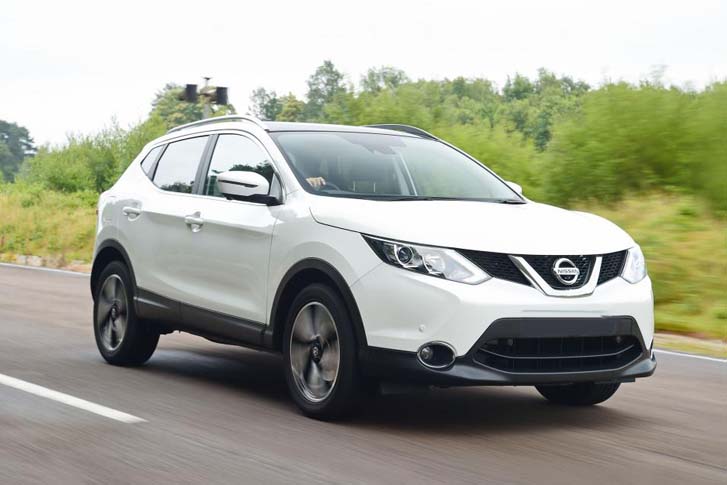
The Nissan Qashqai is a compact crossover SUV produced by the Japanese car manufacturing label Nissan since 2006. For the first generation, the Qashqai sold under the name Nissan Dualis in Japan and Australia. Now Qashqai is in its second generation, which was released in 2014, the new model is only badged as Qashqai.
The Nissan Qashqai is the nice family hatchback that considers it’s an SUV. That could have been a process for disaster but Nissan’s engineers accomplished to blend the potentials of both vehicle types to produce a radiantly well-rounded product.
The Qashqai assists up a high quality driving experience along with low noise levels and ride comfort evolving as clear strengths. The handling isn’t really the sharpest in the class but most holders won’t be too put out by that. Economy is worthy along with the 74mpg 1.5-litre dCi rivaling the greenest family-sized cars all around.
Inside its spacious and the build quality is impressive but those who remember the old Qashqai+2 seven-seater will be dissatisfied with the new Qashqai as it is only accessible with five-seats. For two more seats, consumers should directly look towards the larger Nissan X-Trail instead.
The diesel engines obtainable on the Nissan Qashqai come mainly from sister company Renault. Although the muscular 108bhp 1.5-litre diesel dCi has been around for a while, unceasing development means it revs effortlessly and is noise levels are submissive at idle. Its real strength comes in the brilliant economy it returns though. The engine supplies decent performance, too, and feels more sparkling on the road, all thanks to the amalgamation of prompt throttle response and the specific six-speed gearbox’s well-chosen ratios.
Elsewhere in the engine range Nissan proposes a strong 128bhp 1.6-litre dCi diesel, a 1.2-litre DIG-T petrol and a 1.6-litre DIG-T petrol. The lively 1.6 dCi and 1.2 DIG-T units are offered along with a selection of the standard 6-speed manual (non-automatic) gearbox or the Xtronic auto – a CVT that shifts easily and keeps engine noise down. The 1.6-litre DIG-T suggests 161bhp and is the Qashqai’s speediest engine along with a 0-62mpg time of 9.1s.
The 1.6-litre diesel is the Qashqai’s most sustaining engine with durable mid-range torque and a 0-62mph time of only 9.9s compared to 11.9s in the 1.5 dCi models. It’s also the single unit presented with the Qashqai’s All Mode 4×4 set-up. If you desire to take your Qashqai off-road, it’s the only choice but it does appear with a price and fuel economy penalty and the majority of holders will discover the 1.5 dCi 2WD car perfectly sufficient most of the time.
That takes us to the 1.2-litre DIG-T 115 petrol engine. It’s the entrance-level unit in the range but don’t let that put you off. It’s noiseless and muscular enough for urban riding. If you do lots of longer trips, pay a little bit more for a diesel but for most, the petrol will do the ideal job.
One thing’s for unquestionable: the second-generation Nissan Qashqai looks far more sexy and upmarket than the original model.
The overall shape is typical crossover, with a lifted ride height, roof rails and black plastic trim giving a familiar uneven off-roader look. Up front, the Nissan Qashqai features a sharp nose with angular headlamps and distinguished LED running lights, while the twin chrome bars on the grille add a touch of interest. At the rear, the LED tail-lamps wrap around the corners of the car and on to the tailgate.
The fresh Nissan Qashqai is impressively reasonable, especially the 1.5dCi diesel, which attains 74.3mpg on the shared cycle and is road tax free cheers to excellent CO2 figures of 99g/km. That clearly means it’ll be a cost-effective company car, also. The 1.6-litre diesel is equally frugal, claiming 65.7mpg and 115g/km of CO2. Choosing for the excellent Xtronic CVT auto on this design only penalizes things marginally with 62.8mpg and 119g/km.
If you must have petrol Qashqai, a 1.2-litre turbo proposes the same output as the old 1.6 and 57.6mpg (129g/km), while a 1.6 turbo will reach offering 50.4mpg (132g/km). Qashqai values are on par with opponents but equipment levels tend to be somewhat higher, especially in terms of safety kit.
The comfy seven-seater Nissan Qashqai +2 is no more – the new Qashqai proposes more space for passengers and luggage than before in reply to owner feedback. Anyone desiring seven seats will have to choose for the new Nissan X-Trail instead. The Qashqai’s 430-liter luggage capacity is very impressive. Fold the rear bench seat flat and the capacity increases to 1,585 liters. Better still, there’s a compartment under the boot floor for storing the parcel shelf.
The Nissan Qashqai is 4,377mm in length and 2,070mm in width including the wing mirrors. It’s lower than both cars too, giving away around 80mm in height to the Yeti. Compared to a typical family hatchback like the Ford Focus, the Qashqai is very similar in size. The main difference is the extra height that’s such a central part of the crossover’s appeal. Where the Focus stands 1,469mm tall, the Qashqai towers 1,590mm off the tarmac, this extra gives easier access and an elevated driving position.
All Nissans decently come with a three-year/60,000 mile warranty, which is around average for this class. If you need more cover, it’s worth mentioning that the Hyundai ix35 comes along with a five-year warranty and the Kia Sportage has a pretty decent seven-year warranty.
To sum up, we can surely say that Nissan Qashqai is the decent and smart SUV all around. It’s simply fun to drive and the interior is well-built.
The styling is up to the mark and the engines are very economical as well. So, overall the Nissan Qashqai is very reasonable SUV. What do you think about this masterpiece now?


